Korean Regex Hacks: Validating Numbers, Addresses and more
 Alex Khant
Alex Khant
The world is a diverse place, and this diversity extends to the standards of dates, phone numbers, PO box numbers, and more used in different countries. South Korea is no exception, as it has its own unique set of formats and rules that can sometimes be a head-scratcher for outsiders.
Back in 2021, my adventure into the world of coding involved tackling the intricate and specific Korean rules governing user input fields using regular expressions. I encountered a myriad of challenges along the way, but ultimately, my persistent efforts and ability to find solutions yielded positive results, and I emerged from the experience with a newfound appreciation for the power of Regex. This post is a result of that journey, and I hope it will provide valuable insights for anyone looking to navigate the complex terrain of Korean regex expressions.
As a result, I've created a list of common regex expressions. This list is by no means an exhaustive collection as there are plenty of patterns to match in Korea.
Use this regex tester to play with expressions, and feel free to comment in the section below.
Birthdate
A Typical Korean date format: YYMMDD. We need to match the year, then the month, and lastly - the day.
/^[0-9]{2}(0[1-9]|1[0-2])(0[1-9]|[1,2][0-9]|3[0,1])$/
Korean Resident Registration Number
The first 6 digits are a birthdate, the 7th digit indicates the gender. Even numbers - female, odd - male.
We allow matching only the following numbers: 0, 1, 2, 3, 4, and 9 because the rest of the numbers are used to identify foreign residents. The 8th - 11th digits designate birthplace & community center, 12th digit - is used to distinguish persons having the same birth date and place of birth.
The last digit stands for a checksum calculation performed on the other digits.
/^[0-9]{2}(0[1-9]|1[0-2])(0[1-9]|[1,2][0-9]|3[0,1])-[0-4,9][0-9]{6}$/
Foreigner Alien Registration Number
The 7th digit should only accept 5, 6, 7, 8 where even numbers - female, odd - male.
/^[0-9]{2}(0[1-9]|1[0-2])(0[1-9]|[1,2][0-9]|3[0,1])-[5678][0-9]{6}$/
Cell Phone Number
A common format is xxx-xxxx-xxxx. Most of the numbers start with 010, but we want to match all possible cases 010, 011, 016, 017, 018, 019.
/^01([0|1|6|7|8|9])-([0-9]{3,4})-([0-9]{4})$/
Telephone number
The first two-three digits represent area codes.
/^(0(2|3[1-3]|4[1-4]|5[1-5]|6[1-4]))-(\d{3,4})-(\d{4})$/
PO Box Numbers
The old format consists of six digits where the 1st digit stands for the metropolitan city, or province, 2nd digit - region, and 3rd digit - municipality/district/borough. The last 3 digits - town, county division, and area.
The new format has five digits where the first two digits - are area codes, 3rd digit - town, county, or autonomous region, and the last 2 digits are serial numbers.
Old /^[1-7]\d{2}-\d{3}$/
New /^(?:0[1-9]|[1-5][0-9]|6[0-3])-\d{3}$/
Korean Driver’s License
/^\d{2}-\d{2}-\d{6}-\d{2}$/
Korean Passport Number
The number has 9 digits in total. The first digit contains the letters M or S, and the remaining digits are serial numbers.
/^[mM|sS]\d{8}$/
Bank Account Numbers

Government-run Banks
KDB /^[0-9]{3}-[0-9]{4}-[0-9]{4}-[0-9]{3}$/
IBK /^[0-9]{3}-[0-9]{6}-[0-9]{2}-[0-9]{3}$/
Nonghyup /^[0-9]{3}-[0-9]{4}-[0-9]{4}-[0-9]{2}$/
Nationwide Banks
Citi /^[0-9]{3}-[0-9]{6}-[0-9]{3}$/
KEB /^[0-9]{3}-[0-9]{6}-[0-9]{5}$/
Kookmin /^[0-9]{6}-[0-9]{2}-[0-9]{6}$/
Shinhan /^[0-9]{3}-[0-9]{3}-[0-9]{6}$/
Woori /^[0-9]{4}-[0-9]{3}-[0-9]{6}$/
SC /^[0-9]{3}-[0-9]{2}-[0-9]{6}$/
Local Banks
Daegu /^[0-9]{3}-[0-9]{2}-[0-9]{6}-[0-9]$/
Busan /^[0-9]{3}-[0-9]{4}-[0-9]{4}-[0-9]{2}$/
Kwangju /^[0-9]{3}-[0-9]{3}-[0-9]{6}$/
Jeonbuk /^[0-9]{3}-[0-9]{2}-[0-9]{7}$/
Jeju /^[0-9]{2}-[0-9]{2}-[0-9]{6}$/
Internet Banks
Kbank /^[0-9]{3}-[0-9]{3}-[0-9]{6}$/
Kakao /^[0-9]{4}-[0-9]{2}-[0-9]{7}$/
Toss /^[0-9]{4}-[0-9]{4}-[0-9]{4}$/
Business Registration Number
The first three digits belong to a specific tax office, two digits in the middle - and the type of business, the rest are serial numbers and a checksum calculation.
/^[0-9]{3}[-]+[0-9]{2}[-]+[0-9]{5}$/
Vehicle License Plate Number
The license plate number contains 2-3 digits, followed by a combination of two Korean characters and 4 digits at the end.
Meaning of Korean characters: general vehicles(가-마, 거-저, 고-조, 구-주), taxi, buses(아, 바, 사, 자), rental cars(하, 허, 호), delivery vehicles(배)
/^\d{2,3}[가-힣]{1}\d{4}$/
Area Codes Table
Area (English) | Area (Korea) | Code |
Seoul | 서울특별시 | 02 |
Gyeonggi | 경기도 | 031 |
Incheon | 인천광역시 | 032 |
Gangwon | 강원도 | 033 |
Chungnam | 충청남도 | 041 |
Daejeon | 대전광역시 | 042 |
Chungbuk | 충청북도 | 043 |
Sejong | 세종특별자치시 | 044 |
Busan | 부산광역시 | 051 |
Ulsan | 울산광역시 | 052 |
Daegu | 대구광역시 | 053 |
Gyeongsangbuk | 경상북도 | 054 |
Gyeongnam | 경상남도 | 055 |
Jeollanam | 전라남도 | 061 |
Gwangju | 광주광역시 | 062 |
Jeonbuk | 전라북도 | 063 |
Jeju | 제주특별자치도 | 064 |
Postal Codes By Area
Area (English) | Area (Korean) | Codes (range) |
Seoul | 서울 | 01 - 09 |
Gyeonggi | 경기 | 10 - 20 |
Incheon | 인천 | 21 - 23 |
Gangwon | 강원 | 24 - 26 |
Chungbuk | 충북 | 27 - 29 |
Sejong | 세종 | 30 |
Chungnam | 충남 | 31 - 33 |
Daejeon | 대전 | 34 - 35 |
Gyeongbuk | 경북 | 36 - 40 |
Daegu | 대구 | 41 - 43 |
Ulsan | 울산 | 44 - 45 |
Busan | 부산 | 46 - 49 |
Gyeongnam | 경남 | 50 - 53 |
Jeonbuk | 전북 | 54 - 56 |
Jeonnam | 전남 | 57 - 60 |
Gwangju | 광주 | 61 - 62 |
Jeju | 제주 | 63 |
The 7th digit of Resident Registration Number
Digit | Year Range | Gender |
9 | 1800-1899 | male |
0 | 1800-1899 | female |
1 | 1900-1999 | male |
2 | 1900-1999 | female |
3 | 2000-present | male |
4 | 2000-present | female |
5 | 1900-1999 | foreign male |
6 | 1900-1999 | foreign female |
7 | 2000-present | foreign male |
8 | 2000-present | foreign female |
Further Reading
Subscribe to my newsletter
Read articles from Alex Khant directly inside your inbox. Subscribe to the newsletter, and don't miss out.
Written by

Alex Khant
Alex Khant
Hello World! My name is Alex, I am a software developer based out of Seoul, South Korea. While I may not claim expertise as a seasoned writer or blogger, I’m enthusiastic about creating captivating content about tech. Join me on this blog as I dive into technology reviews, coding insights, theoretical discussions, and more. I’ll also share my personal career experiences and challenges on this blog. My ultimate aim is to share my experiences, educate others, and demystify complex concepts by providing clear explanations and simplified insights.